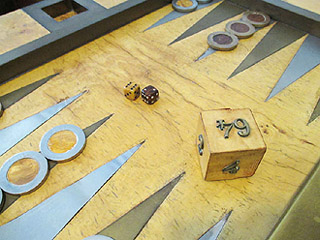|
| Magriel's NYT Columns |
 WEST BERLIN — In West Germany, backgammon groups have formed in almost every major city. The center of backgammon activity in West Berlin is a cafe, Le Fiacre, which is situated on a corner of the Kurfürstendamm, the Broadway of this city. Enthusiasts gather here every evening for some lively games, many of which are played outdoors.
WEST BERLIN — In West Germany, backgammon groups have formed in almost every major city. The center of backgammon activity in West Berlin is a cafe, Le Fiacre, which is situated on a corner of the Kurfürstendamm, the Broadway of this city. Enthusiasts gather here every evening for some lively games, many of which are played outdoors.
The diagrammed position occurred during such a game between two of this city’s best players, Hans Jürgen Bud-Monheim and Lutz Loschke.
Bud-Monheim (Black) has already doubled and reached a favorable position. Black is well ahead in the race, with all but one of his men already in his home board. Thus his only concern is to bring the last remaining man (on the 16-point) to safety. White, however, has built a strong home position and is lurking on the 5-point, waiting for a chance to catch Black.
|
| Black to play 2-2. |
One strategy is to gamble everything on White’s next roll by playing 16/8. With this play, Black moves as close to home as possible, but gives White a 3-shot. Of course, if White misses, Black will have no further problems — nevertheless, the risk of being hit by leaving a direct shot is unacceptably high. By definition, a man is exposed to a direct shot if he is within six pips of his opponent. An indirect shot (7 or more pips away) is considerably less likely to be hit than a direct shot.
On the other extreme, Black could minimize his immediate chance of being hit by keeping as far away from White as possible. By staying on the 16-point, he gives White only one specific combination, 6-5, with which to hit next roll. Unfortunately this conservative strategy also has little to recommend it because it leaves Black still stranded in White’s outfield. Black has very few combinations that bring him all the way home in one roll, so this play merely postpones the danger.
The correct play is 16/12, 3/1(2), steering a middle course by moving partway forward. Black employed a common strategy in such cases: Come as close as possible while still staying out of range of a direct shot. Stopping on the 12-point allows White to hit with 7’s (6 chances out of 36), but then gives Black excellent prospects for getting home next roll.
Note that stopping on the 14-point, and so giving White 9’s to hit with is also possible. However, the significantly improved chances of getting home safely from the 12-point instead of the 14-point more than compensate for the very slightly increased risk of being hit.
Rollout
 Tom Keith 2013 |
|
Money play White owns 2-cube Black rolls 2-2 1296 games with VR Checker play: 2-ply Cube play: 3-ply Red |
| 2-2: | Game | G | BG | Equity | ||||
| 1 | 16/12, 3/1(2) |
W L |
.7688 .2312 |
.0302 .0116 |
.0003 .0002 | +0.5111 |

| (b) |
| 14 | 16/8 |
W L |
.6544 .3456 |
.0222 .0184 |
.0003 .0004 | +0.2340 | (0.2771) | (a) |

|
|

